“What’s your name?
Dark. Yours?
How old are you? Double your fears. ”
Reverie (Dream 6. Florence Milan 9 January 2019)
The young artist Reverie owes her name to Gaston Barchelard’s Poetics of rêverie. Pursuing this fatal predestination, her work has always investigated the unstable boundary between rational thought and dream by laying bare her emotional and psychic states during performative or poetic actions. One of her latest projects is librosogni (dreamsbook), an artist book (published by Skira) conceived as a dream diary in which for months she has noted her nocturnal visions, cataloging them by date and place of manifestation. The result is a sort of psychic self-portrait, cruel and sweet at the same time, in which pages laid out with a very sensitive and almost illegible handwriting alternate with blurred and hand-edited photographs, in which words become a structural and graphic element. Biological discomforts, feelings, hallucinations and loves are mixed in the artist’s complex and labyrinthine dreams, but these residues of her personal experience are spontaneously traced by the reader to universal concepts (such as life, death and rebirth) that enclose the fragile human existential story.
Emanuela Zanon: Remembering dreams regularly is not easy at all because usually their impression lasts only a few moments after waking up. To make librosogni come true (in which you tell 99 dreams experienced over 8 months) did you have to follow any particular discipline or is oneiric memory your natural gift?
Reverie: librosogni was born exactly like a personal mnemonic exercise. Not only nomen omen, the theme of the dream has always been a fruitful field of investigation for me that I explored through the most diverse studies and disciplines. Two years ago I decided, in parallel with other productions, to develop a personal alphabet in relation to the dreamlike, considering the latter the most sincere mirror of reality, of society, of man. So over time, as I worked on new bronzes and ceramics and new public performances that represented collective dreams, I realized that for months I had been unable to remember my dreams. Deepening my studies, I decided to apply to myself a series of techniques useful for recording fragmented mental activity during sleep. Together with these practices, I opened my notebook on the cover of which I engraved “librosogni” and, despite some initial difficulties, the exception became a habit: with recurrence I managed to remember at least a detail or sensitive sensation or people involved … I transcribed any type of dream as it was born; whether it was a daydream, a nightmare or a tactile memory, I brought it back. Going forward I realized that this exercise was becoming a body of work that could have both a cathartic and maieutic function for everyone. If in fact for the performances I asked the public to get naked, I would have felt at fault if I had not put myself on the same level: this was the first reason that led me to share myself uncensored. I gradually understood that the experience of the individual can be a collective exhortation to tell each other more, to live more without even hiding from yourself. The latter theme is even more current in a reality that is purely virtual and made of masks, both at the level of external impositions and for internal choices. The reflection of the dream is our true mirror and we must not be afraid to really look at each other. Now, some of those dreams have become “silk dreams”, large light flags that I printed on fine fabric and stopped between two closed glasses in a particular mirror frame: to reflect every day on a dreamlike vision that can represent a past, a future, a present. In general, returning to the memory of dreams as a “gift”, it usually happens to me that I have anticipatory dreams of everyday life that lead me to live the days that I will have to face in a few hours, or appointments or meetings that will have to occur. They are so true that sometimes when I woke up I happened to think that everything had already happened … In this recent period of quarantine, I confess that I have not been able to dream except some recent dream “illuminations” starting from the second phase after the lock down. And attempts to resume a rewrite exercise have been frustrating. In the lethargy of Time we have lived, my dream-wake relationship has become even more destabilized and I have not found in the sound of ambulances a sweet melody that cradled sleep …
In librosogni the fragmented perception of the body that one experiences during a dream translates into photographs of details, such as face or hands, or into surrogates of the body such as its shadow, the food that will feed it or its footprints in the environment. Do you think that there may be a true perception of the bodily self or that everything is our mental and emotional projection?
On the one hand, I am convinced that dreams are in the absolute sense the most concrete mirror of our inner being. On the other hand, they tell us about our life through symbols and represent a key for understanding that opens not only the universal doors of our lives, but also of the most personal things we can experience. In summary, I believe they are the projection of ourselves: absolute and univocal mirrors of the universal and the subjective. As regards specifically the images of the book you mention, the “physical dreams” are unique works that I have been making by hand for five years by modifying large black and white film prints (50×75 cm). For me they represent real dreams, captured with a stolen shot. These works are configured without a definition of the time and place in which I made and modified the shot; they also lack a specific title other than “physical dream”. I think that perception in the dream, as well as the vision of an image in general, represents the truth of a look beyond the surface, determined by the moment, the sensitivity, the experienced circumstances, the background … it is absolutely subjective and not answers absolute truths. Just in relation to this last reflection, only some of my shots have become “physical dreams”; I used a jet script that modified them, representing a thought of the moment; I instinctively understood that I had to express it in that imaginative moment, without linking it to the meaning of the image at the moment of its realization … Like a double game of dreamlike creation: matryoshka of guided dreams.
The introduction of handwriting, which recalls certain performative aspects of Narrative Art and which at times approaches drawing, corresponds to a search for authenticity. How can spontaneity be reconciled with aesthetics?
Not setting the goal of reconciling them. The aesthetic that I prefer in my research work is that of the everyday, of the apparently anti-graceful, of the error, of the not perfect … of the truth. I believe that acting coherently, with respect to one’s being and thinking, leads to making art in the most diverse directions in which it reveals itself. As far as my experience is concerned, the cacography, the bad song or the stolen shot, with their conceptual and instinctive value at the same time, represent a vision of the world that I feel significant as a sphere of art lived and intensely authentic.
Some symbols recur in book dreams, including the rose that accompanies you as an attribute, paraphrasing classical mythology. What meaning does this element have for you and why is it so important in your work?
Reverie with the ebony rose? The idea of the attribute to the Greek makes me smile … As for the emblematic meaning in the strict sense, this flower has physically accompanied me for five years. In fact, I decided to wear a rose every day as a symbolic dedication to Art, the woman I married [editor’s note: a private performance, 6 July 2016, Prato, Carlo Palli Archive]. Like her, the rose is the most abused flower at all levels, bearer of multiple meanings. The rose like art is multifaceted and such is the most synthetic quality with which to describe it. In reality, therefore, the rose is like a shadow in relation to my work. I think it is paradoxically correct to speak of an “epithet” even if stripped of epic but out of pure sense of poetic practicality. It is part of it even if silent. From the rose a graft was born: the “rosagiglio”. In fact, I gave Art my life in purity and this last word represents an important part of me and my path. In fact, despite being immersed in life, in society and in today’s world and my commitment to create new works, I can swim in admixtures, visions and encounters while always keeping an intrinsic note of purity alive. So the white rose with the unripe green petal joined the lily. I used to give roses as moments: like hourglasses, even the flower marks time and represents it and remembers it, becoming memory once withered. In casastudio (homestudio) in Milan I have a collection of memories, or dried roses. At the moment the rose that I wear every day is a bronze test of mine (for a work of mine made long ago) together obviously with the scent of rose, my shadow-physical-intangible precisely…
Transcribing the evanescent visions of dreams into words implies a process of reworking the dream experience which in the book translates into an elastic symbiosis between dream and poetry. What relationship do you think between these two elements?
I do not have a way of writing that is immediately legible neither from a purely graphic point of view, as it can be seen in librosogni, nor in terms of phraseology and composition of the speech. Even in a simple greeting I get lost in neologism, in the non-convention of punctuation, in the disharmonic harmony of inversions of words, in the synesthesia used with simplicity …
I stretch the elastic
Between dream and poetry
And I smile playing to live
I look at deforming mirrors: they lengthen, shrink, make the ends enormous and the head very small, the smile or the pout become infinite … and so I look at myself.
Without more deformations. I inquire about myself.
Without reworking. I will inform you of you.
This is how I would have liked to answer you straight away if it hadn’t been a public interview but only an intimate exchange between us. Even if I write straight away, I write poetry. So it is with regard to these immediate writings of the dreams just received as a gift and memory there was no translation: as they appeared, I brought them back in the following minutes and in the same way they went to print. There was not even the technological means of a scan. They were already pdf files that could not be modified: from the beginning I forced myself never to censor myself or not to change any part of the content even if it was negative visions such as rapes or hell of the soul … It had to be me, naked in front to the collective eye. Only if I kept myself pure throughout the journey could I really collect a corpus that was nothing more than a mirror for other bodies. The reworking of which you ask me and which I interpret in the intrinsic relationship of transformation from image to word was natural and alive. If, on the other hand, we wanted to talk in general about the relationship between dream and poetry then we could pleasantly delight ourselves endlessly with quotes from this intense love story …
In recent months, through a special format on your site, you are inviting people to tell you their dreams. How will you use this precious collection of new dreamlike visions?
Two years ago I dreamed of a place in Milan that strongly attracts me and that is located near my studio: on a poetry stage I could make a long song with a single body-voice that made dreams, nightmares resound, the daydreams of individual people in a collective song. When I started wanting to make my personal dream language a series of performances (“Dreams”) and works (“dream objects”), “The Sleeping Muse” was born. Each of my works has an original text and gesture. In this case, everything was born from the transcription of that dream and the creation of my “sleeping muse”: a unique bronze work, currently in a private collection, which is nothing more than a graft between natural elements and a live cast of my face. From the perfection of Brancusi, one of his works that most accompanies my dreamlike vision, to the humanity of a face and the transience of nature up to the desire to capture right in deep sleep the moment of the most intense dream that there is, the journey in our self. Here is the title explained. Since January 2020 I am collecting, through the format you mentioned (http://www.reverieinarte.com/coro-di-sogni/), the dreams of those who want to be part of this next work. I would like to say that the invitation is warmly addressed and extended to all until early September. You can also send your dream anonymously and it is fine to fill only the spaces you want: in fact, only the transcription of the memory is mandatory. The second part of this collection will see the light in September when, for the first time, I will read the writings and sing freely the dreams received. It will be an intense moment. As with all my performances, working with empathy and believing that the action should be a moment of life lived with the audience, there will be no evidence but everything will happen as it should at that precise moment. As you may have guessed from my previous answers, even the mistake, the discordance, the broken voice, the missing breath will be forms of a new melody. And like all my performances, this too will be summarized in a final work. I am working to make it as easy to use as “book dreams” in fact, my second artist book which – unlike the first, which is only found in private collections and art archives – can potentially reach everyone’s eyes. Now I realize that this last sentence can truly be interpreted as a young dream … but leave me my reveries.

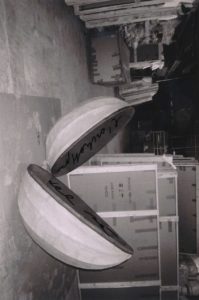
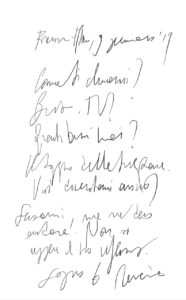
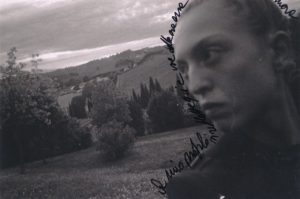


For all the images: Reverie, librosogni, 2019 courtesy dell’artista e di Skira Editore
Graduated in art history at DAMS in Bologna, city where she continued to live and work, she specialized in Siena with Enrico Crispolti. Curious and attentive to the becoming of the contemporary, she believes in the power of art to make life more interesting and she loves to explore its latest trends through dialogue with artists, curators and gallery owners. She considers writing a form of reasoning and analysis that reconstructs the connection between the artist’s creative path and the surrounding context.



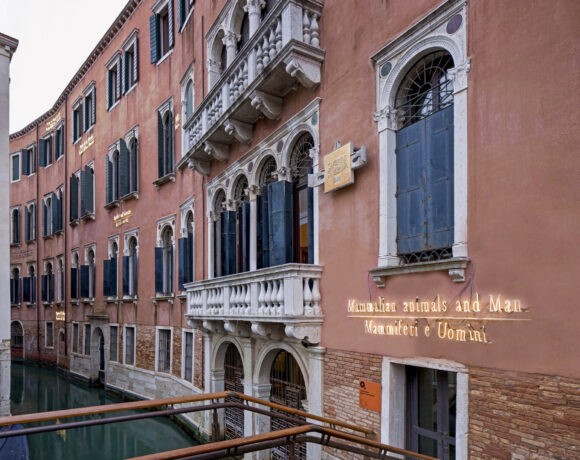
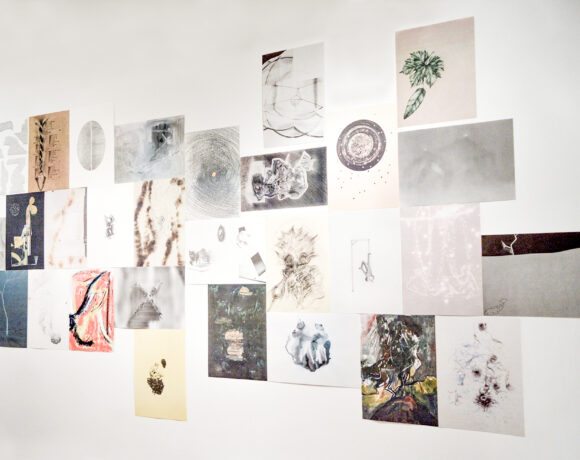

NO COMMENT